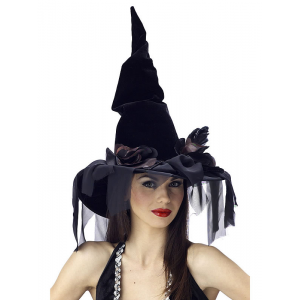 Still today the stereotypical image of a witch is that of an ugly old hag wearing a broad brimmed, tall and black pointed hat. “But where did the hat originate”?
Still today the stereotypical image of a witch is that of an ugly old hag wearing a broad brimmed, tall and black pointed hat. “But where did the hat originate”?
In medieval times, woodcut images of witches show them as wearing a verity of costumes associated with those times, including headscarves and hats of differing fashions. Many are also shown bareheaded with their hair locks blowing in the wind.
Is it possible that the witches hat is an exaggeration of the tall conical “Dunces Hat”, popular in the royal courts during the 15th century? or the blunt-topped hats worn by the Puritans and Welsh of the same period? At one point long ago, pointed hats were a fashion icon in the city of London (then the fashion capital of Europe), but it took a long time for fashion to trickle into the country, and by the time they did, they became way out of fashion in the city. City folk called Country folk 'pagani' (which means country dweller), much the same as calling someone ‘a hick’, today.
Pointed hats soon became considered Something only the 'pagani' would wear, most were Herbalists and Farmers wife’s who lived in the country and understood the land. Since they were wise to the ways of nature and could grow and harvest herbs, so the pointed hat became associated with the ‘Wise Woman’ or ‘Witch'. During this same period the Christian Church chipped-in and associated pointed hats with the horns of the Devil, by which time they frowned upon their use.
Brimless conical hats have long been associated with male Wizards and Magicians, Goya the famous artist painted witches wearing such hats. It is possible that other artists somewhere along the way added the brim to make the hats more appropriate for women. By Victorian times, the tall black conical hat worn by an old crone became readily identifiable as symbols of wickedness in illustrations of children’s stories and Fairy Tales.
Another possibility is that the witch’s hat may date back to antiquity. Ancient Etruscan coins from the city of Luna depict a head on one side of the coin; some believe it to be the goddess Diana, who is associated with witches. The head on the coin depicts the wearer with a brimless conical hat.
Today most contemporary witches go bareheaded or wear ritual headgear such as headbands with a crescent moon or other religious symbols on it. Normally the symbol is positioned on the forehead. During rituals in which the Goddess and Horned God are represented, the high priestess may wear a headband or a crown, while the high priest may wear a helmet with horns or antlers.
Downloadable books (free):
John Musick - The Witch Of SalemAnonymous - The Laws For Witches
Leo Ruickbie - The Winter Sabbat
Alfred Elton Van Vogt - The Witch








